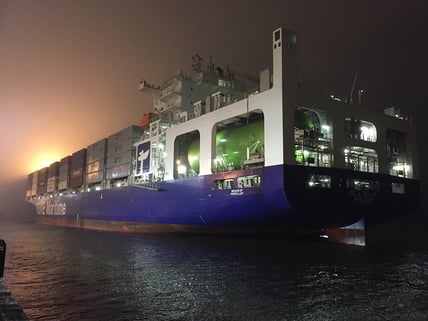Liquefied natural gas (LNG) is a cryogenic natural gas, cooled to its liquid state of minus 162 degrees Celsius (minus 260 degrees Fahrenheit). In converting natural gas to LNG, the volume is reduced by about 600 times, allowing it to be stored and transported effectively.
%20The%20Fuel%20of%20the%20Future%20for%20Shipping%20and%20Transport/LNG%20Dry-Disconnect%20-%20Disconnected%20-%20blog.jpg?width=612&height=459&name=LNG%20Dry-Disconnect%20-%20Disconnected%20-%20blog.jpg)
Once delivered to its destination, LNG is warmed back to its original gaseous state so that it can be used like any other natural gas resource for heating and cooling, cooking, generating electricity, and powering manufacturing/processing operations.
%20The%20Fuel%20of%20the%20Future%20for%20Shipping%20and%20Transport/LNG%20Transfer%20from%20Truck%20to%20Skid%20to%20Ship%20(2)%20-%20blog.jpg?width=612&height=459&name=LNG%20Transfer%20from%20Truck%20to%20Skid%20to%20Ship%20(2)%20-%20blog.jpg)
The transport of LNG has been around for decades, but its growth trajectory has never been higher than it is today. And the reason is quite simple: LNG fills a need driven by the stricter environmental requirements for the shipping industry, which dictates that traditional bunker fuel must be replaced by the use of cleaner fuels. LNG is a special fuel because it requires no after-treatment to meet emissions control and other environmental requirements.
Beginning in 2015, new international emissions regulations apply to sulfur in sensitive marine environments – particularly in “first world” regions such as Europe and North America. Additional regulations covering nitrogen oxides and particles, plus carbon dioxide and other greenhouse gases, will go into effect in 2020.
%20The%20Fuel%20of%20the%20Future%20for%20Shipping%20and%20Transport/Ship%20Powered%20by%20LNG%20-%20blog.jpg?width=612&name=Ship%20Powered%20by%20LNG%20-%20blog.jpg)
The International Maritime Organization (IMO), an agency of the United Nations, has also issued sanctions against the availability and use of “dirty fuels” after 2020, so ship owners and operators are actively seeking alternative fuels that can meet these more stringent emissions criteria.
This blog was excerpted from Liquefied Natural Gas: The Fuel of the Future for Shipping and Transport whitepaper.
